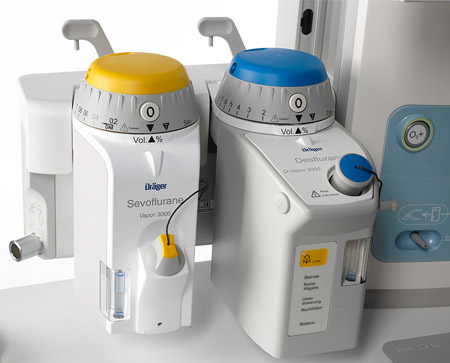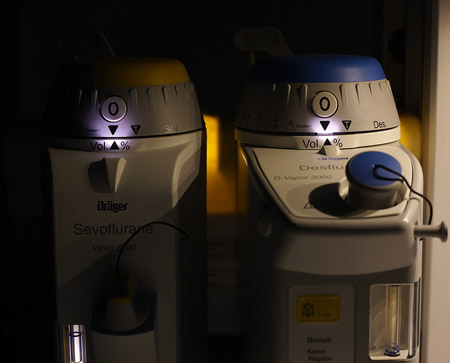- Device Gallery
- Device cockpit
- Mixer unit and status display
- Vapor 3000
- Vapor Mount
- Integrated Breathing System
- External fresh-gas outlet
- CO2 absorber
- Space for storage
- Working surface
- Trolley
- Hooks and brackets
- Anesthetic Gas Receiving System (AGRS)
- Mounting rails
- Column cover
- Cable channel
- Gas Inlet
- Interfaces
- Endotracheal Suction System
- Patient monitoring and IT
- Shelves
- Vapor 3000
- Ventilator (TurboVent 2)
- Ventilation Modes
- Device Monitoring
- Operating Concept
- Abbreviations
- Symbols
- Test
Vapor 3000
Advanced vaporizer with smart functions
So much more than just a vaporizer for volatile agents, the new Vapor 3000 is now even better, even in dark environments. In combination with the Perseus A500 anesthesia workstation, it can even help you monitor and plan your anesthesia for enhanced safety and improved efficiency.

New features for added safety and comfort
The Vapor 3000 incorporates features you know from previous models, such as transport functionality, large filling volume of 300 ml and audible filling level alarms. However, it now includes advanced features that can help you perform anesthesia with enhanced safety and confidence. In addition to ensuring secure storage and application of all current volatile agents, it is now equipped with an easy-open sealing cap as well as setting and filling level illumination. What's more, the Vapor 3000 can now even communicate with the new Perseus A500 anesthesia workstation.
Improved sealing cap design and operation
The newly designed sealing cap can be opened and sealed with just a 90° turn, while its grip clearly indicates the status of the seal; the horizontal grip position tells you that the cap is open; the vertical position means that the cap is sealed. This means you can be sure of the status of the seal at a glance. The control dial features an off (0) as well as a transport setting (T).
Illuminated concentration setting and filling level indicator
The Vapor 3000 now comes with integrated illumination for both the control dial and filling level indicators. This means you can be sure of your supply and your dosage even in dark environments and without the need for additional light sources. The level indicator now magnifies the agent level for better, wide-angle visibility. A blue stripe at the back of the glass further enhances the view of the agent level.

Communication with the Perseus A500
In addition to communication of the control dial setting, alarms, and agent identification, the Vapor 3000 can relay information to the Perseus A500 anesthesia workstation which can be used to predict volatile agent concentration over a period of up to 20 minutes. The prediction of inspiratory and expiratory volatile agent concentration can help you perform low- and minimal-flow anesthesia more safely, more efficiently and more economically in a wide range of patients and clinical situations.
Advanced modelling and data visualization
Predictions are based on advanced mathematical models which take a large number of variables into account. The visualization of prediction and simulation data can help anaesthetists fine tune their experience and promotes efficiency and patient safety. In combination with the Dräger Smart Pilot View, a complete effect site overview is possible - ideal for training and other supervision situations.
Zero preventive maintenance, no re-calibration
The Vapor 3000 is not only safe and easy to use. It also requires no preventative maintenance. Re-calibration is also unnecessary. Its rugged design will provide you with years of care-free operation.
Available versions of Vapor 3000:
- Vapor 3000 for Isoflurane.
- Vapor 3000 for Sevoflurane.
- D-Vapor 3000 for Desflurane.
Vapor View (Option)
When combined with Dräger-Vapor 3000 or D-Vapor 3000, the Vapor View option facilitates the following functions:
- Illumination of control dial and sight glass on vaporizer
- Provision and processing of the following information: -Type of anesthetic agent -Position of the control dial -Reaching the refill mark -Prediction of the anesthetic gas concentration

